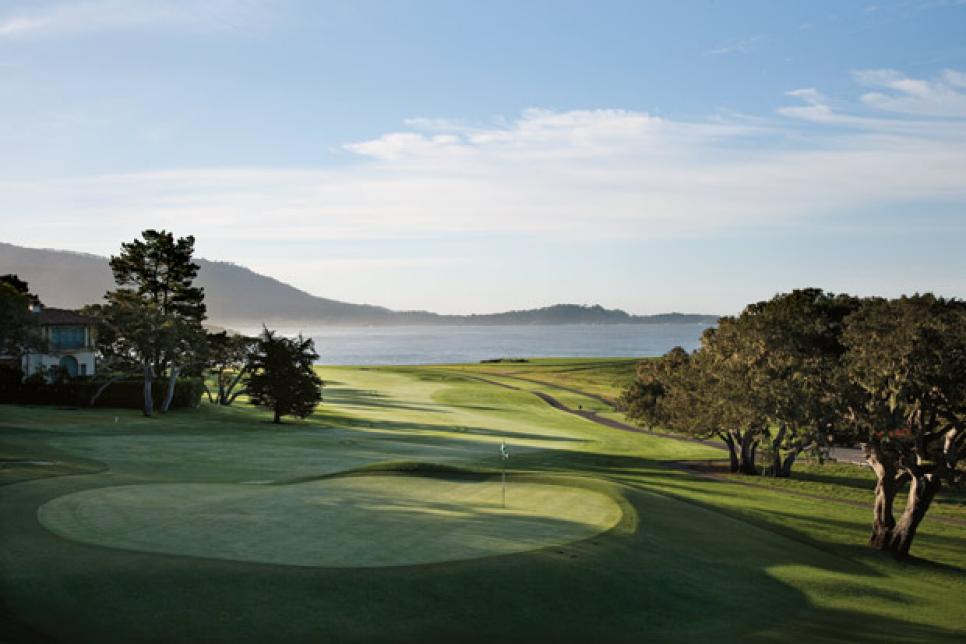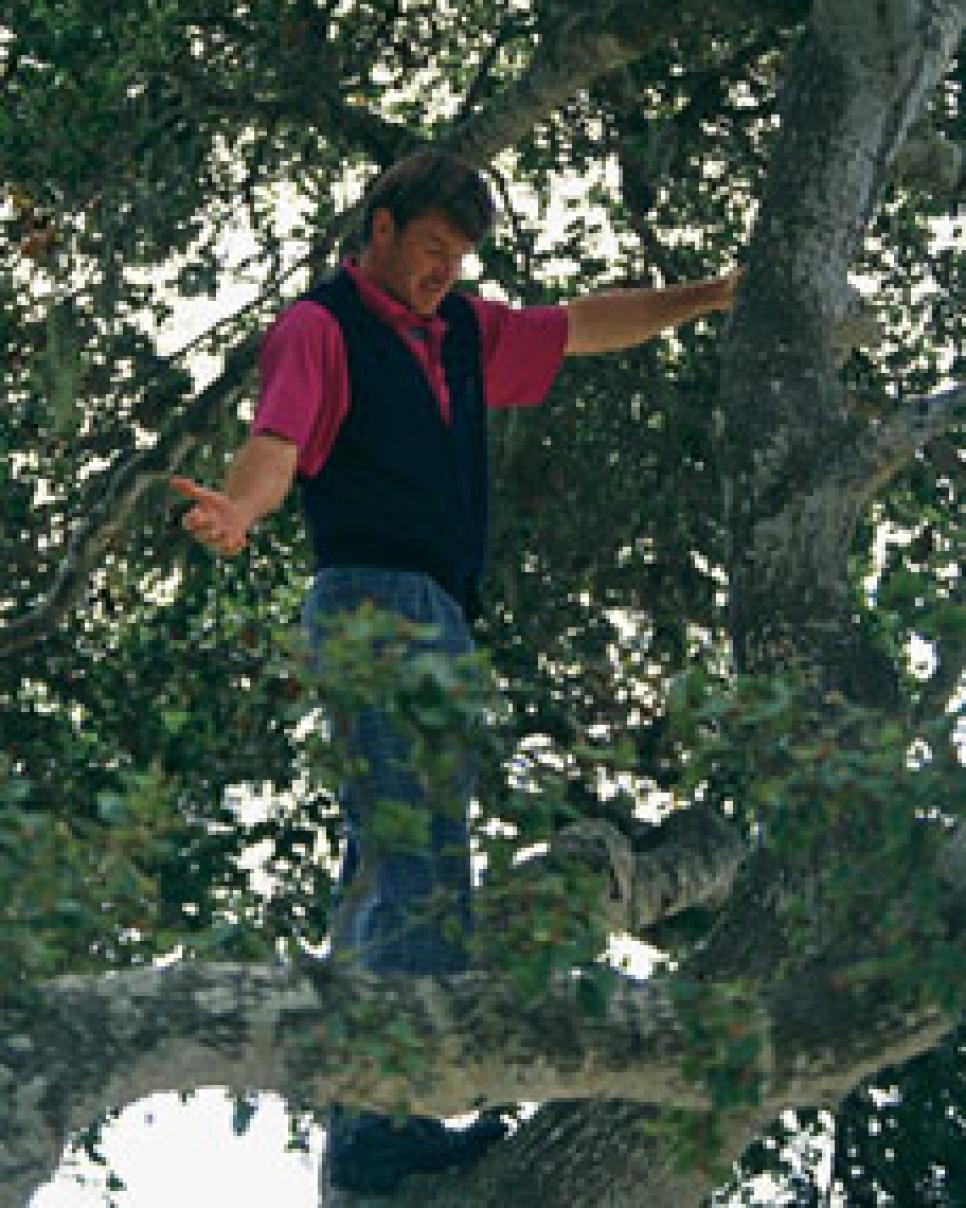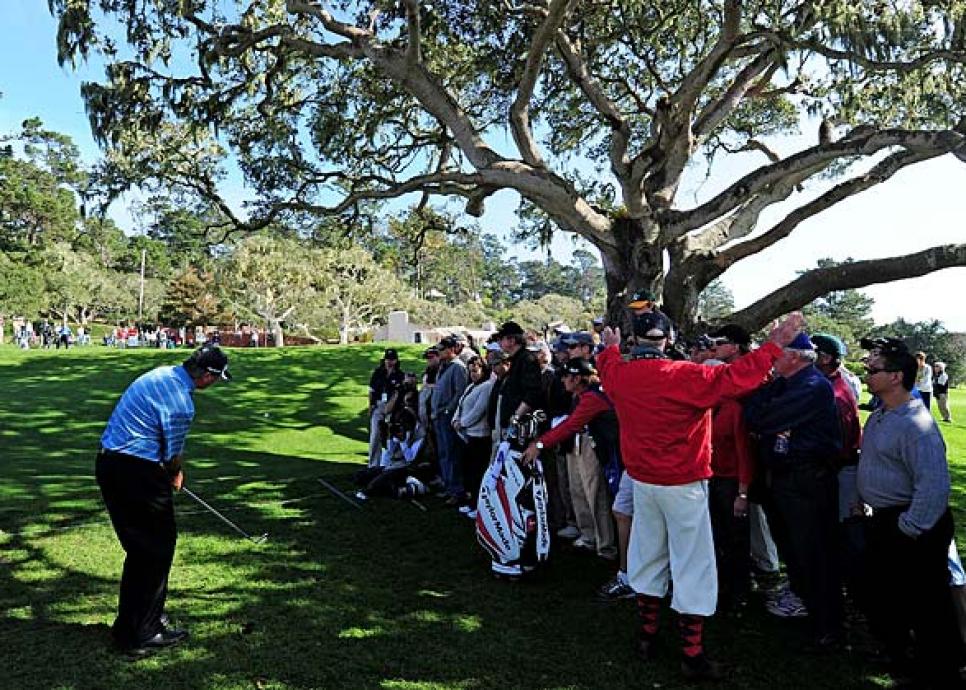News
Ping-Pong by the Pacific

The most devious, card-wrecking hole at Pebble Beach GL is not one of its eight oceanfront holes, although any can produce a double bogey with one bad bounce. No, the really big numbers occur most often on the 580-yard par-5 14th, the longest, but least visually compelling, hole on the course.
There are trees and out-of-bounds all along the right side of this sharp dogleg right. To see the ocean from the 14th, you have to twist your head. To see its fairway bunkers off the tee, you have to stand on your tiptoes. To see the green, or rather the left portion, where all the hole locations are, you'd better be in a blimp overhead.

The green looks like a Salvador Dali melted watch, something more suitable for skateboarding than putting, the entire right side simply a concave curve dropping about eight feet from back to front. The tiny, pinnable left side is a plateau 10 feet above the fairway, hidden behind the high lip of an ominous bunker. To the left and rear of the 14th green are shaved slopes instead of deep rough -- errant shots will roll farther away and recoveries present annoying indecision. Pitch? Lob? Bump? Putt? Some golfers have tried all four in a single encounter with the hole.
Pebble's 14th has a long history of grabbing championship golfers and slapping them silly. In the second round of the 1992 U.S. Open, Nick Faldo pushed his 9-iron approach into an oak tree to the right of the green, had to climb the tree to search for the ball, never found it, played his provisional from a greenside bunker and escaped with a triple-bogey 8. He later said he wasn't worried about getting up and down, he was just worried about getting down.
Arnold Palmer had even more tree trouble on the 14th. Trailing Jack Nicklaus by a shot in the last round of the 1967 Bing Crosby National Pro-Am, Palmer went for the green in two, hit a Monterey pine on the right and bounced out-of-bounds. He tried the same shot again, hit the same tree again and suffered the same result. By the time he holed out, he had scored a quadruple-bogey 9 and ultimately finished third. The following day, a storm swept through and lightning struck the offending tree, toppling it.
"I remember seeing that tree laying across the fairway," Palmer says. "I didn't know about the lightning. I thought a fan had snuck out and cut it down." In the 1977 PGA Championship at Pebble Beach, Danny Edwards six-putted the 14th for a 9. In the 1982 U.S. Open, reigning Amateur champion Nathaniel Crosby took a 9. And this past February, in the final round of the AT&T Pebble Beach National Pro-Am, three contenders -- Alex Prugh, Bryce Molder and Paul Goydos -- turned the 14th green into a ping-pong table and scored 9s.
Goydos was leading the tournament at the time. He watched Molder's struggles from the fairway, then duplicated them. His approach ended up at the front of the green, the same spot as Molder, and his pitch likewise went over the green and completely down a left-hand chipping swale. His first chip only made it halfway up the slope then rolled back down. His next chip cleared the hill and nearly rolled down the front of the green again. He three-putted from there, lost the lead, finished with 78 and a T-5.
How nasty was the 14th in this year's final round of the AT&T? The hole saw just eight birdies against 17 bogeys, five double bogeys, one triple bogey and three quadruples. One of those bogeys was by David Duval, who three-putted from 43 feet and lost the tournament by one.

The chipping area left of the green -- scene of much of this year's follies -- was created last year by Mike Davis, senior director of rules and competitions for the USGA, "to balance things out" for the U.S. Open. He had the entire slope mowed at collar height, completely down the hill, ending beneath the canopy of a live oak, figuring that would be fairer than deep rough under the tree.
But the Monday after this year's AT&T, Davis toured the course and adjusted that chipping area by moving the closely mown portion halfway up the hill, returning rough to the area beneath the tree. "If a guy happens to get his ball down at the tree," Davis says, "he can hit a bump-and-run up over the rough and catch the closely-mown grass on the top half of the hill. Conversely, if a ball just trickles over the hill, it'll only roll halfway down. He may end up in the rough, but at least he's on an uphill lie and has a shot."
He insists his adjustment had nothing to do with the trio of 9s from the day before. "Ironically, a week before, I'd been sent pictures of it by the superintendent, and I sent him a note saying we're going to have to change it because it's just not going to work out right," Davis says. "What happened Sunday solidified my view."
So will Pebble's 14th play easier for the U.S. Open than it did in February? Not very likely. The cup each day will be on the tiny top-left shelf, just 1,600 square feet of target. The surface will be firmer and faster than it was for the AT&T.
Davis calls it perhaps the toughest three-shotter of any U.S. Open venue. "If you've never seen it in person, you probably scratch your head and wonder what's so hard about it," he says. "But if you get there and see how high in the air it sits, and how much it rolls off, it's devilish. If you miss the green, you have to be Houdini to get it up and down."
The present 14th green dates from 1929. A 1947 photograph shows its sloping right side had been converted to fairway, leaving only the tiny left plateau as the green. By the early 1950s, according to other photos, the green size had been fully reinstated. Would Davis ever consider raising the height of cut on the right portion, something between green height and collar height, to keep some balls from rolling to the bottom portion of the green?
"At one time I gave some thought about making it collar height," he says. "But under the Rules of Golf, we have to define where the green is, where you can lift your ball and clean it. I don't know if you can have two heights of cut on a single putting surface. I suppose you can. I don't know that it's ever come up before.
"At several events," adds Davis, "we've varied the height of cut from green to green. At Winged Foot [in 2006], I had them have a special mower that was set slightly higher for certain greens. But we told the players up front, and the entire green was cut that way, not just a portion of it."

Beginning in 2003, after a group that included Arnold Palmer purchased the resort, nearly every hole at Pebble Beach has been modified under the supervision of Palmer's design company. New bunkers have been added to the first, second, fourth, sixth, 14th, 15th and 18th holes. Palmer even had a tall cypress planted on the right side of No. 14 in the vicinity of the pine that smote him in '67. Several greens have been rebuilt. But the 14th green remains untouched.
"That hole has cost me an Open and a Crosby," Palmer says. "If I live long enough, if I'm owner long enough, I may just change that green."
But for now, players in this year's Open will have to approach Pebble's 14th with care, if not trepidation, pitching to a blind uphill green, probably downwind, with trouble on every side, using a short iron devoid of the deep, sharp grooves of years past.
Here's betting the 14th will wreck a card or two before the week is out.